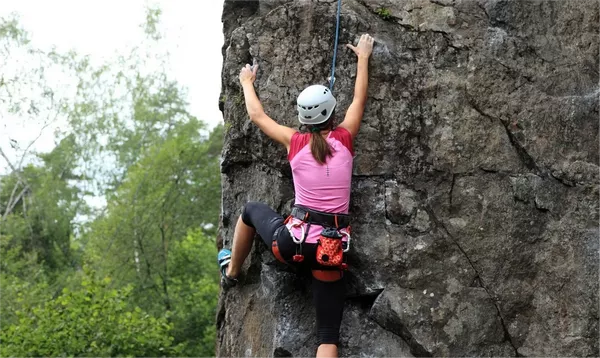Outdoor climbing is an exhilarating pursuit that combines physical challenge with natural beauty. Whether scaling rocky cliffs or bouldering in rugged terrain, the right apparel is essential for both comfort and safety. From protection against the elements to freedom of movement, selecting the appropriate clothing can greatly enhance your climbing experience. In this comprehensive guide, we’ll explore the key factors to consider when choosing what to wear for outdoor climbing.
Understanding the Climbing Environment
Before delving into specific clothing choices, it’s important to understand the environment in which you’ll be climbing. Outdoor climbing takes place in a variety of settings, each with its own unique conditions. Consider factors such as temperature, weather patterns, sun exposure, and terrain type when planning your attire.
For example, climbing in colder climates or at higher elevations may require insulated layers to retain body heat, while climbing in hot and sunny conditions necessitates lightweight, breathable fabrics to prevent overheating. Similarly, climbing on abrasive rock surfaces may call for durable clothing that can withstand abrasion, whereas climbing in densely forested areas may require protection against branches and thorns.
Layering for Versatility
One of the fundamental principles of outdoor clothing is layering. Layering allows you to adjust your attire to accommodate changing conditions and exertion levels throughout the climb. A typical layering system consists of three main components: a base layer, an insulating layer, and an outer shell.
1. Base Layer: The base layer is in direct contact with your skin and serves to wick moisture away from your body, keeping you dry and comfortable. Look for moisture-wicking fabrics such as merino wool or synthetic blends, which are quick-drying and odor-resistant.
2. Insulating Layer: The insulating layer provides warmth by trapping heat close to your body. Fleece jackets or synthetic insulated jackets are ideal choices for this layer, as they offer warmth without adding bulk and retain heat even when wet.
3. Outer Shell: The outer shell is your first line of defense against wind, rain, and snow. Choose a waterproof and windproof jacket with breathable properties to stay dry and comfortable in inclement weather. Look for features such as adjustable hoods, pit zips for ventilation, and reinforced areas for durability in high-wear areas.
Freedom of Movement
Freedom of movement is crucial when climbing, as it allows you to reach for holds and execute technical maneuvers with ease. When selecting clothing for outdoor climbing, prioritize garments that offer stretch and flexibility. Stretchy fabrics such as elastane or spandex blends are ideal for pants and shorts, while articulated designs and gusseted crotches provide enhanced mobility.
Avoid clothing with restrictive fits or excessive bulk, as these can impede your range of motion and hinder your climbing performance. Opt for form-fitting or tailored garments that move with your body without constriction.
Protection and Durability
Outdoor climbing can be rough on clothing, with abrasive rock surfaces, sharp edges, and abrasive brush posing potential hazards. Choose clothing that offers adequate protection and durability to withstand the rigors of climbing.
For pants, opt for abrasion-resistant materials such as nylon or reinforced fabrics in high-wear areas such as the knees and seat. Consider wearing knee pads or leg gaiters for additional protection against scrapes and cuts.
Similarly, select shirts and jackets made from durable materials that can withstand abrasion and resist tearing. Look for reinforced stitching, reinforced elbows, and abrasion-resistant panels to prolong the lifespan of your garments.
Sun Protection
Sun protection is essential when climbing outdoors, especially at higher elevations where UV radiation is more intense. Exposure to the sun’s rays can lead to sunburn, premature aging, and an increased risk of skin cancer. To protect yourself from the sun, wear clothing with built-in UPF (Ultraviolet Protection Factor) or apply sunscreen to exposed skin.
Choose lightweight, long-sleeved shirts and pants with a tight weave to block out harmful UV rays. Wide-brimmed hats or caps with neck flaps can provide additional protection for your face, neck, and ears. Don’t forget to wear sunglasses with UV-blocking lenses to protect your eyes from glare and damage.
Footwear
Last but certainly not least, proper footwear is essential for outdoor climbing. Climbing shoes are designed to provide traction, support, and sensitivity on rock surfaces, allowing you to grip holds securely and maintain balance. Choose climbing shoes that fit snugly without being overly tight, as a comfortable fit is crucial for precision and control.
For approaches and descents, opt for approach shoes or hiking boots with sticky rubber soles for traction on rugged terrain. Look for features such as toe caps and ankle support to protect your feet from impacts and provide stability on uneven surfaces.
Conclusion
In conclusion, selecting the right apparel for outdoor climbing is essential for comfort, safety, and performance. By considering factors such as the climbing environment, layering for versatility, freedom of movement, protection and durability, sun protection, and footwear, you can ensure that you’re properly equipped for your climbing adventures. So before you head out to the crag or boulder field, take the time to carefully choose your clothing and gear, and enjoy the thrill of outdoor climbing to the fullest.

